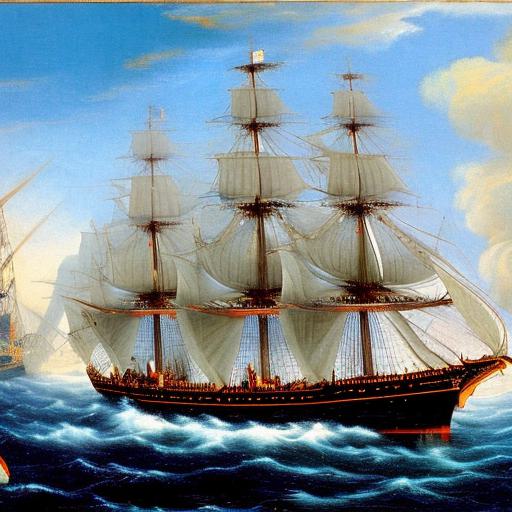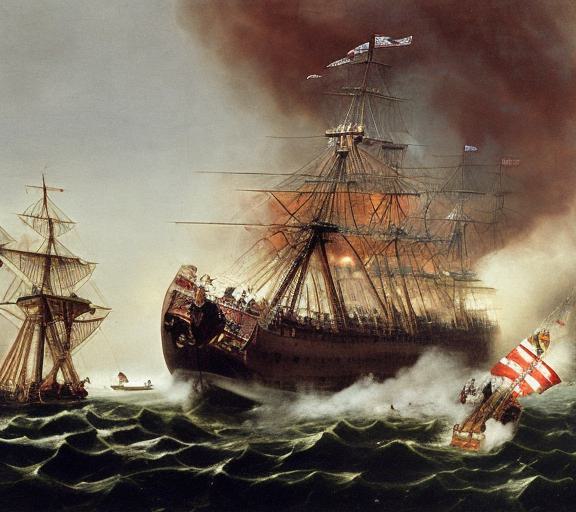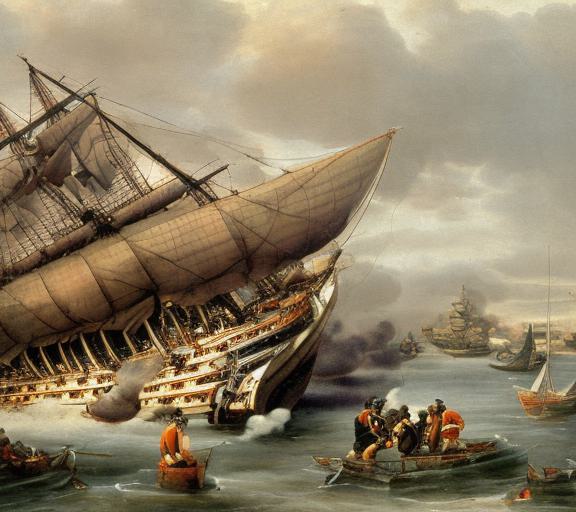The warship Vasa was a symbol of Sweden’s imperial ambitions and military might in the 17th century. It was also a colossal failure that sank on its maiden voyage in 1628, becoming a national embarrassment and a maritime mystery. In this blog post, I will explore the history and significance of the warship Vasa, from its construction and demise to its recovery and preservation.
What was the warship Vasa?
The warship Vasa was a Swedish warship built between 1626 and 1628 under the orders of King Gustavus Adolphus, who was engaged in a war with Poland-Lithuania over the control of the Baltic Sea and its territories. The king wanted a powerful and impressive flagship that would intimidate his enemies and assert his authority as the leader of the Protestant cause in Europe. He commissioned a ship that would be larger and more heavily armed than any other ship in the world at that time. ¹
The warship Vasa was constructed at the navy yard in Stockholm by private contractors, overseen by a Dutch master shipbuilder named Henrik Hybertsson. The ship was designed with two gun decks, 64 bronze cannons, and a crew of about 450 men. The ship was also richly decorated with hundreds of wooden sculptures and carvings that depicted the king’s achievements, virtues, and aspirations. The ship’s name, Vasa, referred to the king’s family name and coat of arms, which featured a sheaf of wheat. ¹²
The warship Vasa was launched in March 1628, after two years of construction. However, it soon became apparent that the ship had serious stability problems, as it was too top-heavy and narrow for its weight and size. The ship’s design had been altered during the construction to accommodate more guns and decorations, without proper calculations or tests. The ship’s captain, Söfring Hansson, conducted a stability test by ordering 30 men to run from side to side on the upper deck, which caused the ship to tilt dangerously. He stopped the test after three runs, fearing that the ship would capsize. He reported the results to the vice admiral, Klas Fleming, who dismissed his concerns and ordered him to sail anyway. ¹²
How did the warship Vasa sink?
The warship Vasa set sail on its maiden voyage on August 10, 1628, with great fanfare and celebration. Thousands of people gathered on the shore and on other ships to witness the departure of the magnificent vessel. The king himself was away in Poland, leading his army in the war, but he had sent his instructions and expectations for the ship’s performance and destination. The ship was supposed to join the rest of the Swedish fleet at Älvsnabben, an island near Stockholm, where it would serve as the flagship of the reserve squadron. ¹²
However, the warship Vasa never reached its destination. After sailing only about 1,300 meters (1,400 yards) from the shore, it encountered a gust of wind that made it heel over to its port side. Water rushed in through the open gun ports on the lower deck, flooding the ship and causing it to sink rapidly. The whole ordeal lasted less than 15 minutes. Many people on board managed to escape by swimming or being rescued by nearby boats, but some 30 to 150 people drowned in the disaster. The exact number of casualties is unknown, as there is no reliable record of how many people were on board at the time of sinking. ¹²³
The sinking of the warship Vasa was a huge shock and humiliation for Sweden and its king. It was also a major loss of resources and manpower for the Swedish navy, which was already outnumbered by its enemies. The king ordered an inquiry to find out who was responsible for the catastrophe, but no one was ever convicted or punished. The blame was shifted among various parties, such as the shipbuilders, the contractors, the naval officers, and even the king himself. The main cause of the sinking was identified as a lack of proper balance and stability in the ship’s design and construction, but no one admitted fault or negligence. ¹²
How was the warship Vasa recovered?
The warship Vasa lay at the bottom of the sea for over 300 years, forgotten and buried in mud and silt. Its location was known, but it was considered too difficult and dangerous to salvage. Some of its valuable bronze cannons were retrieved by divers in the 17th century, but the rest of the ship remained intact and preserved by the cold and brackish water of the Baltic Sea. ¹²
The warship Vasa was rediscovered in the late 1950s by a Swedish amateur archaeologist and engineer named Anders Franzén, who had a passion for finding and exploring old shipwrecks. He had been searching for the Vasa for years, using historical records, maps, and sonar equipment. He finally located the ship in 1956, in a busy shipping lane in Stockholm harbor. He confirmed his discovery by bringing up a piece of black oak wood from the ship’s hull. He then contacted the Swedish authorities and convinced them to support a salvage operation. ¹²
The warship Vasa was salvaged in 1961, after five years of preparation and work. It was a complex and risky undertaking, involving divers, engineers, archaeologists, and naval officers. The ship was lifted from the seabed by a series of cables and pontoons, and then towed to a dry dock on Beckholmen island. The ship was greeted by thousands of spectators and media representatives, who witnessed the emergence of a historical treasure. The ship was remarkably well-preserved, with most of its wooden structure and sculptures intact. The divers also recovered thousands of artifacts and human remains from inside and around the ship, which provided valuable insights into the life and culture of 17th-century Sweden. ¹²
How is the warship Vasa preserved?
The warship Vasa is currently housed in the Vasa Museum, a specially built museum on Djurgården island in Stockholm. The museum opened in 1990, after nearly 30 years of conservation and restoration work on the ship and its artifacts. The museum is one of Sweden’s most popular tourist attractions, and has been visited by over 35 million people since 1961. ²
The warship Vasa is displayed in a large hall that recreates the original appearance and atmosphere of the ship. The ship is supported by a steel cradle that prevents it from collapsing under its own weight. The ship is also constantly monitored and treated to prevent deterioration and damage from factors such as humidity, temperature, light, and microorganisms. The ship’s wooden surface is sprayed with polyethylene glycol (PEG), a wax-like substance that replaces the water in the wood cells and prevents shrinkage and cracking. The ship’s sculptures and carvings are also cleaned and restored to their original colors and details. ²
The warship Vasa is not only a museum piece, but also an active research subject. The museum has a team of experts who study various aspects of the ship’s history, construction, sinking, recovery, preservation, and interpretation. The museum also collaborates with other institutions and researchers around the world who share an interest in maritime archaeology and history. The museum aims to increase public knowledge and appreciation of the warship Vasa and its significance for Sweden and the world. ²
Conclusion
The warship Vasa was a Swedish tragedy and treasure that sank on its maiden voyage in 1628, becoming a national embarrassment and a maritime mystery. It was also a Swedish triumph and pride that was recovered in 1961, becoming a historical treasure and a cultural symbol. It is now one of the world’s best-preserved and most-visited 17th-century ships, which offers a unique glimpse into Sweden’s imperial ambitions and military might in the 17th century.
References
(1) Vasa (ship) – Wikipedia. https://en.wikipedia.org/wiki/Vasa_%28ship%29
(2) Welcome to the Vasa Museum. https://www.vasamuseet.se/en.
(3) Vasa | Swedish warship | Britannica. https://www.britannica.com/topic/Vasa-warship.
Bibliography
– Cederlund, C.O., ed. (2006). Vasa I: The Archaeology of a Swedish Warship of 1628 . National Maritime Museums of Sweden.
– Hocker, F.M., ed. (2011). Vasa: A Swedish Warship . Medströms Bokförlag.
– Hocker, F.M., & Wendelius-Lindqvist, J., eds. (2006). Vasa’s World: Proceedings from an International Seminar . National Maritime Museums of Sweden.
– Soop, H.M., ed. (1986). The Power and the Glory: The Sculptures of The Warship Wasa . National Maritime Museums of Sweden.
Tags
Divi Meetup 2019, San Francisco
Related Articles
Unappreciated Greatness
Life and Legacy of Jahangir of the Mughal Empire. Jahangir ruled over one of the largest empires in human history during his lifetime, yet few people outside of South Asia have heard of him. I aim to shed light on the life and legacy of this remarkable figure,...
The Plague Doctor’s Diary
A Personal Account of the Turin Epidemic of 1656. I am writing this diary to record my experiences and observations as a plague doctor in Turin, the capital of the Duchy of Savoy, during the terrible epidemic that has afflicted this city and its surroundings since the...
The Timeless Beauty of Bustan
Unveiling the Secrets of Saadi Shirazi's Masterpiece.In the realm of Persian literature, few works have captured the essence of love, spirituality, and morality quite like Bustan (The Orchard) by Saadi Shirazi. This 13th-century masterpiece has left a lasting impact...
Stay Up to Date With The Latest News & Updates
Explore
Browse your topics of interest using our keyword list.
Join Our Newsletter
Sign-up to get an overview of our recent articles handpicked by our editors.
Follow Us
Follow our social media accounts to get instant notifications about our newly published articles.









